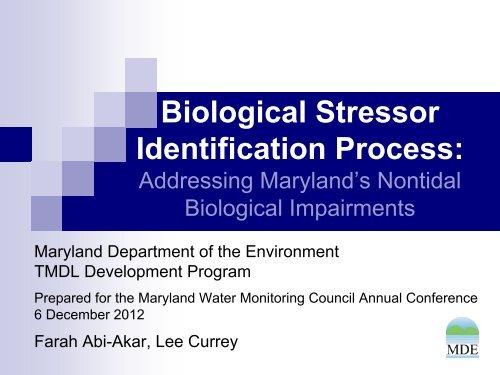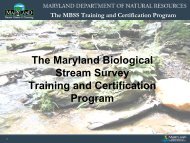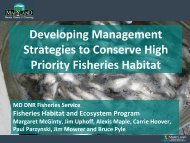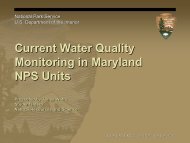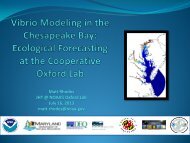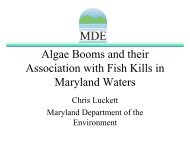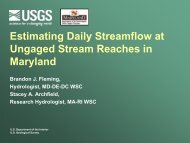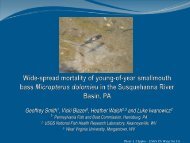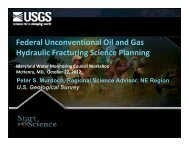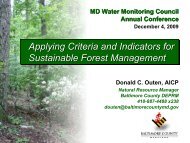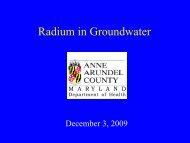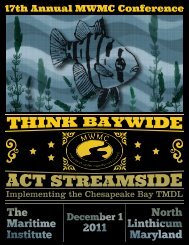Farah Abi-Akar (MDE) - Maryland Department of Natural Resources ...
Farah Abi-Akar (MDE) - Maryland Department of Natural Resources ...
Farah Abi-Akar (MDE) - Maryland Department of Natural Resources ...
You also want an ePaper? Increase the reach of your titles
YUMPU automatically turns print PDFs into web optimized ePapers that Google loves.
Biological Stressor<br />
Identification Process:<br />
Addressing <strong>Maryland</strong>’s Nontidal<br />
Biological Impairments<br />
<strong>Maryland</strong> <strong>Department</strong> <strong>of</strong> the Environment<br />
TMDL Development Program<br />
Prepared for the <strong>Maryland</strong> Water Monitoring Council Annual Conference<br />
6 December 2012<br />
<strong>Farah</strong> <strong>Abi</strong>-<strong>Akar</strong>, Lee Currey
Overview<br />
• Background<br />
• Methods<br />
• Results
Background
Background<br />
• Clean Water Act’s Total<br />
Maximum Daily Loads<br />
(TMDLs)<br />
Allowable in-stream limits<br />
Point & non-point sources<br />
Are developed when a Water<br />
Quality Standard is not met,<br />
and when tech. standards<br />
aren’t enough
Background<br />
• MD Water Quality Standards (WQS)<br />
For a body <strong>of</strong> water, the combination <strong>of</strong>:<br />
• A designated use, and<br />
• The water quality criteria designed to protect that<br />
use.<br />
Designated uses include swimming, drinking,<br />
shellfish harvest, protection <strong>of</strong> aquatic life<br />
• DNR’s Benthic Index <strong>of</strong> Biological Integrity (BIBI)<br />
and Fish Index <strong>of</strong> Biological Integrity (FIBI)
Background<br />
• WQS not met <br />
Watershed gets listed on MD’s 303(d) list <strong>of</strong><br />
impaired waters (Integrated Report).<br />
Assessment Unit Designated Use Cause Indicator<br />
Liberty Reservoir<br />
Aquatic Life and<br />
Wildlife<br />
Sedimentation/siltation<br />
Unknown<br />
Liberty Reservoir<br />
Aquatic Life and<br />
Wildlife<br />
Phosphorus (Total)<br />
Dissolved Oxygen<br />
Antietam Creek<br />
Aquatic Life and<br />
Wildlife<br />
Cause Unknown<br />
Fish and Benthic IBIs
Background<br />
• WQS not met <br />
Watershed gets listed on MD’s 303(d) list <strong>of</strong><br />
impaired waters (Integrated Report).<br />
Need a TMDL to fix it.<br />
• Listed for sediment TMDL to reduce sediment.<br />
• Listed for nitrogen TMDL to reduce nitrogen.<br />
• Listed for biology TMDL to reduce… what<br />
–What TMDL(s) should we develop to improve<br />
biology What is making fish & benthics
What is responsible<br />
for reducing fish &<br />
benthics’ biological<br />
integrity<br />
We need to find the guilty<br />
stressors in each watershed.<br />
Round up the suspects and<br />
begin investigation!<br />
Biological<br />
Stressor<br />
IDentification
How the BSID works
Domain<br />
• Freshwater (non-tidal)<br />
• Stream orders 1-4<br />
• 8-digit watershed scale
Data<br />
• DNR’s <strong>Maryland</strong> Biological Stream Survey<br />
Rounds 2 and 3 (2000-2009)<br />
Conditions & biology paired<br />
Most comprehensive<br />
Consistent sampling & analysis methods<br />
• Land use: Chesapeake Bay Program<br />
Spatially consistent (vs: RESAC + NCLD)<br />
More detail in urban areas<br />
Consistent with TMDL Program<br />
• & RESAC Impervious, & State Roads
Data<br />
• Acknowledgements<br />
<strong>MDE</strong> BSID Section<br />
MD DNR MBSS<br />
Chesapeake Bay Program<br />
EPA ORD<br />
University <strong>of</strong> <strong>Maryland</strong><br />
Versar<br />
Programs: SAS and R
Goal: Compare Bio to Stressors<br />
• How Using case-control statistics<br />
Commonly used in epidemiology:<br />
Mantel-Haenszel Odds or Risk Ratios<br />
Categorizes all samples into groups, then<br />
compares numbers in each group.<br />
Groups characterized by:<br />
• Biology: or <br />
• Stressor: Above or Below<br />
• Region and order
Goal: Compare Bio to Stressors<br />
1. Bio<br />
Cases vs. Controls<br />
FIBI < 3<br />
FIBI ≥ 3<br />
BIBI < 3<br />
BIBI ≥ 3<br />
# in 8-digit watershed # in physiographic region
Goal: Compare Bio to Stressors<br />
Controls grouped by:<br />
1. Bio<br />
1 st 2 nd +<br />
Eastern Piedmont<br />
Highland<br />
1 st 2 nd +<br />
1 st 2 nd +<br />
Coastal
Goal: Compare Bio to Stressors<br />
2. Stressors<br />
Potential culprits:<br />
•Habitat<br />
•Sediment<br />
•Water Chemistry<br />
•Acid sources<br />
•Land use – Agriculture<br />
•Land use – Anthropogenic<br />
•Land use – Urban
Goal: Compare Bio to Stressors<br />
2. Stressors<br />
Every 8-digit watershed gets investigated for<br />
every one <strong>of</strong> these stressors.
Goal: Compare Bio to Stressors<br />
2. Stressors<br />
Stressor above limit vs. Stressor below limit
Goal: Compare Bio to Stressors<br />
Stressor Thresholds<br />
2. Stressors<br />
• A.K.A. Defining the line between and <br />
for each stressor<br />
• Some are already defined in COMAR, by<br />
DNR, or in literature, e.g.:<br />
Low lab pH:
Goal: Compare Bio to Stressors<br />
Stressor Thresholds<br />
2. Stressors<br />
• What about stressors without defined<br />
thresholds<br />
High conductivity<br />
Low shading<br />
Low % forest in 60-meter buffer<br />
• Made our own.<br />
Includes R1 & non-random<br />
Nice big sample sizes (72-304)
Goal: Compare Bio to Stressors<br />
Stressor Thresholds<br />
2. Stressors<br />
• Compared stressor levels,<br />
within BIBI & FIBI groups,<br />
within regions.<br />
• 80% confidence intervals<br />
• Strengthen analysis with<br />
bootstrapping (10,000x)
High Conductivity,<br />
Highland<br />
1. Do these overlap<br />
No they are<br />
statistically different.<br />
Threshold set at<br />
mean <strong>of</strong> Fair.
1. Do these overlap<br />
Yes they are not<br />
statistically different.<br />
Low % Forest,<br />
Coastal<br />
2. Do these overlap<br />
No they are<br />
statistically different.<br />
Threshold set at the<br />
mean <strong>of</strong> Poor & Fair.
… for all potential stressors, for all regions.
Goal: Compare Bio to Stressors
Goal: Compare Bio to Stressors<br />
Two-way contingency table: every stressor, every watershed
Goal: Compare Bio to Stressors<br />
• Hypothesis: Sub-par biology will be<br />
correlated to sub-par water quality.<br />
Or,
Goal: Compare Bio to Stressors<br />
Odds Ratio = ad<br />
bc<br />
=<br />
• One odds ratio per watershed, per stressor<br />
• If the OR > 1, the result is significant. The<br />
stressor is likely to be impacting biology.<br />
• Mantel-Haenszel exact test, 90% CI p value
Thanks to odds ratios,<br />
probable stressors<br />
have been ID’d in each<br />
watershed.<br />
Now, how much risk do<br />
we attribute to each
Attributable Risk<br />
• The portion <strong>of</strong> samples with poor to very poor<br />
biological conditions as a result <strong>of</strong> the stressor<br />
The % <strong>of</strong> cases that are the stressor’s “fault”<br />
AR <br />
Proportion<br />
cases<br />
-<br />
Proportion<br />
controls<br />
AR<br />
<br />
<br />
<br />
<br />
a<br />
a<br />
<br />
c<br />
<br />
<br />
<br />
<br />
<br />
<br />
<br />
b<br />
b<br />
<br />
d
Attributable Risk<br />
• ARs are also combined by category:<br />
Stressors<br />
• Sediment<br />
• Habitat<br />
• Water Chemistry<br />
Sources<br />
• Acid sources<br />
• Land use – Agriculture<br />
• Land use – Anthropogenic<br />
• Land use – Urban
Results
Stressor<br />
above<br />
Cases<br />
6<br />
Controls<br />
9<br />
Example:<br />
Seneca Creek,<br />
Impervious Surface<br />
Stressor<br />
below<br />
4<br />
163
Example: Seneca Creek,<br />
Impervious Surface<br />
Cases<br />
Controls<br />
Stressor<br />
above<br />
Stressor<br />
below<br />
6<br />
4<br />
9<br />
163<br />
Odds Ratio ≈<br />
ad<br />
bc ≈ 6*163<br />
9*4<br />
≈ 27<br />
6 9<br />
Attributable Risk ≈ % cases - % controls ≈ - ≈ 55%<br />
10 172<br />
Therefore:<br />
• Yes, impervious surface is a possible bio stressor in<br />
Seneca Creek.<br />
• Estimated risk attributable to impervious surface: 55%
Group Stressor AR<br />
Sources - Agr High % <strong>of</strong> agriculture in watershed 29% 29% 96%<br />
Sources - Low % <strong>of</strong> forest in watershed 45% 47%<br />
Anthropogenic Low % <strong>of</strong> forest in 60m buffer 18%<br />
Sources - Urban High % <strong>of</strong> impervious surface in 60m buffer 49% 59%<br />
High % <strong>of</strong> impervious surface in watershed 55%<br />
High % <strong>of</strong> high-intensity developed in watershed 38%<br />
High % <strong>of</strong> low-intensity developed in watershed 57%<br />
High % <strong>of</strong> medium-intensity developed in watershed 58%<br />
High % <strong>of</strong> early-stage residential in watershed 44%<br />
High % <strong>of</strong> residential developed in watershed 57%<br />
High % <strong>of</strong> roads in watershed 52%<br />
High % <strong>of</strong> high-intensity developed in 60m buffer 19%<br />
High % <strong>of</strong> low-intensity developed in 60m buffer 55%<br />
High % <strong>of</strong> medium-intensity developed in 60m buffer 49%<br />
High % <strong>of</strong> early-stage residential in 60m buffer 25%<br />
High % <strong>of</strong> residential developed in 60m buffer 58%<br />
High % <strong>of</strong> roads in 60m buffer 10%<br />
Sediment Epifaunal substrate poor 18% 18% 96%<br />
Instream Habitat Concrete/gabion present 18% 48%<br />
Instream habitat structure poor 10%<br />
Riffle/run quality marginal to poor 28%<br />
Water Chemistry High chlorides 34% 76%<br />
High conductivity 62%<br />
High orthophosphate 22%<br />
High lab pH 18%<br />
High total nitrogen 54%
Seneca Output: What wasn’t there<br />
• Atmospheric deposition present<br />
• Agricultural acid source present<br />
• AMD acid source present<br />
• Organic acid source present<br />
• High % <strong>of</strong> agriculture in 60m buffer<br />
• Low % <strong>of</strong> wetland in watershed<br />
• Low % <strong>of</strong> wetland in 60m buffer<br />
• High % <strong>of</strong> rural developed in watershed<br />
• High % <strong>of</strong> rural developed in 60m buffer<br />
• Extensive bar formation present<br />
• Moderate bar formation present<br />
• Bar formation present<br />
• Channel alteration moderate to poor<br />
• Channel alteration poor<br />
• High embeddedness<br />
• Epifaunal substrate marginal to poor<br />
• Moderate to severe erosion present<br />
• Severe erosion present<br />
• Silt clay present<br />
• Beaver pond present<br />
• Channelization present<br />
• Instream habitat structure marginal to<br />
poor<br />
• Pool/glide/eddy quality marginal to poor<br />
• Pool/glide/eddy quality poor<br />
• Riffle/run quality poor<br />
• Velocity/depth diversity marginal to poor<br />
• Velocity/depth diversity poor<br />
• No riparian buffer<br />
• Low shading<br />
• Acid neutralizing capacity below chronic<br />
level<br />
• Acid neutralizing capacity below episodic<br />
level<br />
• Dissolved oxygen < 5mg/l<br />
• Dissolved oxygen < 6mg/l<br />
• Low dissolved oxygen saturation<br />
• Low field pH<br />
• High field pH<br />
• Low lab pH<br />
• High sulfates<br />
• Ammonia acute with salmonid present<br />
• Ammonia acute with salmonid absent<br />
• Ammonia chronic with salmonid present<br />
• Ammonia chronic with salmonid absent<br />
• High total phosphorus
# Watersheds Impacted per Stressor<br />
impsurf 1<br />
COND_LAB1<br />
bimpsurf 1<br />
CL1<br />
WB_MURB1<br />
X60M_MURB1<br />
WB_ROAD1<br />
SO4_LAB1<br />
X60M_ROAD1<br />
X60M_LURB1<br />
X60M_FRST1<br />
WB_REHML1<br />
WB_LURB1<br />
EPI_SUB2<br />
X60M_REHML1<br />
X60M_HURB1<br />
CHANNELbin1<br />
X60M_AGRI1<br />
WB_HURB1<br />
WB_FRST1<br />
INSTRHAB2<br />
INSTRHAB1<br />
TP1<br />
EPI_SUB1<br />
VEL_DPTH2<br />
X60M_REEARL1<br />
RIFFQUAL1<br />
WB_REEARL1<br />
LDOSAT_FLD1<br />
DO_FLD2<br />
RIFFQUAL2<br />
POOLQUAL2<br />
O_PHOS1<br />
DO_FLD1<br />
X60M_RUHML1<br />
WB_RUHML1<br />
TN1<br />
RIP_WID1<br />
EMBEDDED1<br />
WB_AGRI1<br />
PH_LAB1<br />
CONCRETEbin1<br />
CHAN_ALT2<br />
WB_WETL1<br />
AR_FORM_MEbin1<br />
POOLQUAL1<br />
CHAN_ALT1<br />
ANC_LAB1<br />
PH_FLD1<br />
ERODSV_Sbin1<br />
ERODSV_Mbin1<br />
BAR_FORM_Ebin1<br />
VEL_DPTH1<br />
SHADING1<br />
X60M_WETL1<br />
PH_LAB2<br />
ACIDAGRbin1<br />
ANC_LAB2<br />
ACIDADbin1<br />
BEAVPNDbin1<br />
ACIDAMDbin1<br />
TANc2bin1<br />
TANc1bin1<br />
PH_FLD2<br />
BAR_FORMbin1<br />
ACIDORGbin1<br />
TANa2bin1<br />
TANa1bin1<br />
SILTCLAYbin1<br />
0<br />
0<br />
0<br />
1<br />
1<br />
1<br />
1<br />
1<br />
8<br />
666<br />
4 55 4<br />
13<br />
13<br />
13<br />
10 11<br />
11<br />
11 12<br />
12<br />
9 10<br />
10<br />
10<br />
17<br />
16 17<br />
17<br />
17<br />
16<br />
15 16<br />
16<br />
16<br />
43 44<br />
35 36 37 43<br />
35<br />
35<br />
34<br />
31 32<br />
32<br />
32 33<br />
33<br />
30<br />
30<br />
29<br />
29<br />
27<br />
27<br />
26<br />
25<br />
20 21<br />
21 22 24<br />
19<br />
19<br />
0 10 20 30 40<br />
Statewide<br />
Top 5 stressors/sources<br />
1. Impervious surface<br />
2. Conductivity<br />
3. Chloride<br />
4. Medium-intensity<br />
development<br />
5. Roads<br />
5. SO 4<br />
Bottom 5 stressors/sources<br />
1. Silt/clay presence<br />
2. Ammonia<br />
3. Organic acid source<br />
4. Bar formation<br />
5. pH > 8.5<br />
Watersheds
BSID Output<br />
• Analysis <strong>of</strong> stressors and interrelationships
BSID Output<br />
• Watershed-specific<br />
reports
Summary<br />
• Challenges<br />
Sample sizes limited<br />
Uncertainty inherent in thresholds<br />
Accounting for “all” stressors<br />
One stressor at a time<br />
• But…<br />
Provides a systematic, quantitative means <strong>of</strong><br />
addressing non-tidal biological impairments.<br />
Analysis strengthened in several ways (sample size,<br />
bootstrapping, land use consistency…)
What’s next<br />
• Analysis <strong>of</strong> results &<br />
interrelationships<br />
• Updating <strong>of</strong> existing reports &<br />
writing new ones<br />
• Development <strong>of</strong> appropriate<br />
water quality criteria and/or<br />
TMDLs to address results
<strong>Maryland</strong> <strong>Department</strong> <strong>of</strong> the Environment<br />
TMDL Development Program<br />
Biological Stressor Identification Section<br />
Allison O’Hanlon<br />
AOHanlon@mde.state.md.us<br />
Shirley Kirby<br />
Skirby@mde.state.md.us<br />
<strong>Farah</strong> <strong>Abi</strong>-<strong>Akar</strong><br />
F<strong>Abi</strong>-<strong>Akar</strong>@mde.state.md.us<br />
BSID Website<br />
http://www.mde.state.md.us/programs/Water/TMDL/<br />
Pages/Programs/WaterPrograms/tmdl/bsid_studies.aspx<br />
1800 Washington Boulevard | Baltimore, MD 21230-1718<br />
410-537-3000 | TTY Users: 1-800-735-2258<br />
www.mde.state.md.us


